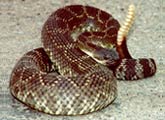Snake Alert
Last Updated: October 6, 2020 2:25:36 PM PDT
Give feedback

Learn how to identify and avoid poisonous and beneficial snakes and what to do if bitten by a rattlesnake.
- Contact EH&S Pest Management for snakes near or in UCSD facilities: ehspest@ucsd.edu, (858) 534-4534
Rattlesnake characteristics
Rattlesnakes are the only poisonous snakes native to Southern California. Notable characteristics are:
- Distinctive rattle at end of tail. A vibrating rattle causes a warning rattling sound. However, rattlesnakes don't always rattle before striking.
- Broad triangular head, vertically elliptical pupils, heavy-bodied frame, and slender neck.
- Length: 1 to 6 feet.
Avoid snakes
Snakes are found where rodents and small mammals live. On campus, they may be encountered in areas adjacent to canyons, open fields, and undeveloped land. During the day, they often sun themselves on rocks and ledges. Snakes usually try to escape and do not attack unless cornered.
- Stay alert when walking near canyons or undeveloped land.
- If you see a snake, do not disturb it. Move away quickly.
- If you hear a rattlesnake, stand still until you are sure of its location, then move away quickly.
- Examine playgrounds before allowing children to enter.
- Never step or reach into an area you cannot see.
Snake-proof yards and buildings located near canyons or undeveloped land
- Install tight-fitting doors, screens, and crawl space covers.
- Block all cracks and holes in foundations and floors.
- Snake-proof fences by installing quarter-inch mesh hardware cloth, minimum height 36 inches. Bury the bottom edge of the mesh cloth a few inches below ground level.
- Clear away vegetation and debris. Snakes use vegetation or debris for nesting areas and climbing.
- Eliminate sources of food, water, and outdoor hiding places in the immediate area. Reduce gopher, rabbit, ground squirrel, rat, and mouse populations.
In case of snakebite
Rattlesnake bites rarely result in death. Of the 8,000 people bitten annually, only about 12 die from the bite. If a bite occurs:
- Remain calm.
- Call 9-1-1 and get the victim to the hospital immediately.
- Immobilize the bitten limb. Don’t apply a tourniquet or constriction band and don’t attempt to cut the wound or suck out the venom. Don’t apply ice to the wound.
- Wash the skin over the bite with soap and water. Cover the wound.
- Don’t give the victim any form of alcohol.
Who to call for non-emergencies (typical response time: 1 working day)
- Campus and SIO: EH&S Pest Management, (858) 534-4534 or e-mail ehspest@ucsd.edu
- Medical Center facilities:
- For areas around the Hillcrest hospital call Facilities Engineering call (619) 543-6454
- For the East Campus including Thornton hospital, Shiley Eye Center, Moores Cancer Center call (858) 534-4534
- Medical Center EH&S can be reached at (858) 657-7166
- Campus Police: (858) 534-4357
For more information, contact EH&S Pest Management, (858) 534-4534.
Notice: Environment, Health & Safety does not provide pest control advice or help to individuals or agencies outside UC San Diego. Area residents should contact their local animal control agency or exterminator for assistance.